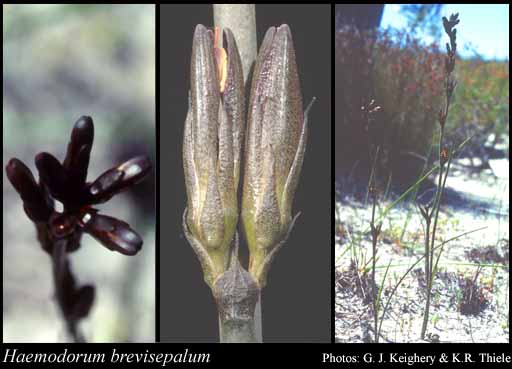- Reference
- Fl.Austral. 6:420 (1873)
- Conservation Code
- Not threatened
- Naturalised Status
- Native to Western Australia
- Name Status
- Current
Bulbaceous, perennial, herb, 0.08-0.35 m high. Fl. black/brown-black, Sep to Dec. Sandy clay, clay, white or grey sand, granite. Seasonally-wet locations.

Scientific Description
Leaves flat, 170-240 mm long, 0.8-1 mm wide; bristles or hairs on the leaf margin absent; hairs on the surface of the leaf absent (leaf surfaces glabrous). Scape present, glabrous, 190-250 mm long. Inflorescence subtended by a bract 4-8.5 mm long, with several flowers; floral bracts 4-5 mm long; pedicels present, 2-4 mm long; flowers 9-10 mm long. Perianth glabrous, radially symmetrical, uniformly coloured, black or brown, clearly with three inner and three outer tepals, the inner segments 7.5-8 mm long. Stamens three, in one level; filaments 0-0.3 mm long; anther 1.3-1.4 mm long, without an appendage. Style 7.5-8 mm long. Flowers in September, October, November or December. Occurs in the Geraldton Sandplains, Swan Coastal Plain, Avon Wheatbelt, Jarrah Forest, Mallee and Esperance IBRA bioregion(s), of the South-west Botanical Province.
Distribution
- IBRA Regions
- Avon Wheatbelt, Esperance Plains, Geraldton Sandplains, Jarrah Forest, Mallee, Swan Coastal Plain.
- IBRA Subregions
- Fitzgerald, Geraldton Hills, Katanning, Lesueur Sandplain, Northern Jarrah Forest, Perth, Recherche, Southern Jarrah Forest, Western Mallee.
- Local Government Areas (LGAs)
- Armadale, Canning, Carnamah, Chittering, Coorow, Dandaragan, Esperance, Gnowangerup, Greater Geraldton, Kalamunda, Kent, Murray, Northampton, Plantagenet, Ravensthorpe, Serpentine-Jarrahdale, Swan, Toodyay, Wickepin, York.